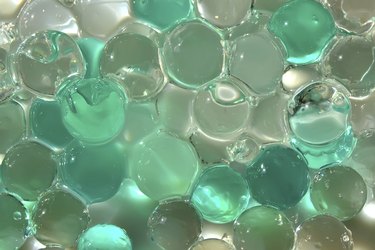
Sustaining a houseplant without soil in a clear vase of what look like glass marbles might seem like botanical alchemy. Those marbles -- commonly known as water or hydrogel beads -- are actually super-absorbent sodium polyacrylate crystals. After drinking in up to 300 times their weight in fertilizer-enhanced water, the beads nourish vased houseplants for up to two months. Using them as a garden soil amendment, however, may cause serious problems.
Choosing Your Houseplants
Video of the Day
Foliage plants that thrive in dim, humid environments are most likely to grow well in water beads. Common candidates include the arrowhead vine (Syngonium podophyllum) and peace lilies (Spathiphyllum spp.). Arrowhead vine is perennial in U.S. Department of Agriculture plant hardiness zones 10 through 12, while peace lilies do well in zones 11 and 12. Breathtaking exceptions to the foliage rule are moth orchids (Phalaenopsis spp.), also hardy in USDA zones 10 through 12.
Video of the Day
Preparing Your Water Beads
Preparing water beads to sustain a houseplant is a relatively simple process. Mix 1 teaspoon -- or the label's recommended amount -- of liquid, 12-4-8 all-purpose plant food in a sealable, 1-gallon container of distilled water. Using liquid plant food is critical. Crystallized plant food may not dissolve completely and could interfere with the bead's water absorption. After mixing the solution, add the manufacturer's specified amount of dehydrated crystals to the water. Close the container; the wet crystals are extremely slippery and cleaning a spill is difficult. When the crystals have finished expanding, usually between six and 12 hours after immersion, pour them into a strainer to drain the excess solution.
The Transfer
After placing your potted plant in a sink, lift it from its container and gently rinse the growing medium or soil from its root ball. Trim any damaged roots and clean up dead leaved and debris, then submerge the root ball in a container of clean water for two or three hours. It needs this time to recover from the shock of lifting and adjust to a liquid-only medium. Set the plant in a vase large enough for the roots and add enough beads to stabilize and nurture the plants. If you have small children who might mistake the beads for candy, display your creation out of their reach.
Ongoing Care
Some leaf yellowing and root decay may occur as your plant adapts to growing in the water beads. Simply remove the dying leaves. If necessary, lift the plant from the vase, trim its rotted roots and replace it. As the plant absorbs water, the beads shrink and eventually need rehydrating. It may take a month or two for you to noticeable shrinking. When you do, remove the plant to a container of fresh water and place the crystals in fertilizer-enhanced distilled water until they're fully expanded. Used as a houseplant soil replacement, the beads usually last one to two years. When they're no longer absorbent, dispose of them in a closed container according to your local waste regulations.
Water Beads and Garden Plants
Some manufacturers suggest using water beads as a moisture-retaining amendment for garden plants. Significant research on their effectiveness has yielded widely varying results, according to the University of Arizona Extension agent Jeff Schalau. One major drawback to using them is that as the beads degrade, they release dangerous concentrations of the neurotoxin acrylamide into the soil. Schalau recommends substituting water-retaining mulch and compost for the beads.
- Got Waterbeads?: FAQs
- Got Waterbeads? Waterbeads: The Perfect Plant Partner
- Crystal Soil: Crystal Soil
- University of Arizona Cooperative Extension Yavapai County: Backyard Gardener – Hydrogels: Are They Safe?
- Crystal Soil: How to Pot Plants in Crystal Soil
- Little Shop of WaterBeads: Water Beads
- Missouri Botanical Garden: Syngonium Podophyllum
- Missouri Botanical Garden: Spathiphyllum (Group)
- Missouri Botanical Garden: Phalaenopsis (Group)
- Washington State University Puyallup Research and Extension Center: The Myth of Polyacrylamide Hydrogels: "Polyacrylamide Hydrogels Are Environmentally Safe Substances That Reduce Irrigation Needs"